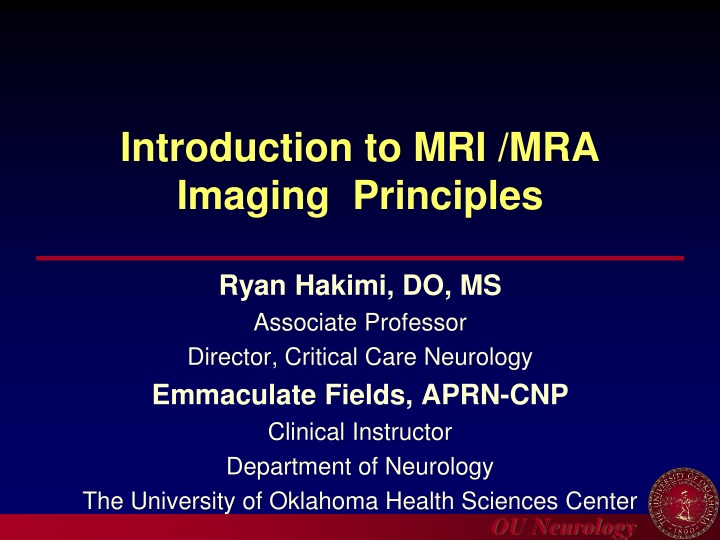
MRI and MRA Imaging Principles
Explore the basics of MRI and MRA imaging, including advantages, disadvantages, and sequences. Learn about the uses, limitations, and benefits of MRI technology in neurology. Gain insights into identifying pathologic lesions and interpreting MRIs effectively.
Download Presentation

Please find below an Image/Link to download the presentation.
The content on the website is provided AS IS for your information and personal use only. It may not be sold, licensed, or shared on other websites without obtaining consent from the author. If you encounter any issues during the download, it is possible that the publisher has removed the file from their server.
You are allowed to download the files provided on this website for personal or commercial use, subject to the condition that they are used lawfully. All files are the property of their respective owners.
The content on the website is provided AS IS for your information and personal use only. It may not be sold, licensed, or shared on other websites without obtaining consent from the author.
E N D
Presentation Transcript
Introduction to MRI /MRA Imaging Principles Ryan Hakimi, DO, MS Associate Professor Director, Critical Care Neurology Emmaculate Fields, APRN-CNP Clinical Instructor Department of Neurology The University of Oklahoma Health Sciences Center OU Neurology
Disclosures FINANCIAL DISCLOSURE Nothing to disclose UNLABELED/UNAPPROVED USES DISCLOSURE Nothing to disclose Some of the slides have been adapted from teaching materials used at the University of Oklahoma Health Sciences Center OU Neurology
LEARNING OBJECTIVES Upon completion of this course, participants will be able to: Understand the basics of MR imaging Identify and describe basic cerebral anatomy Establish an approach to MR interpretation Identify pathologic lesions found on MRI/MRA of the head OU Neurology
MRI basics MRI uses a magnet and radio-wave pulses to create cross-sectional pictures between external magnetic fields and tissues within the patient MRI is an intensity based study vs CT scan which is density (hyperintense vs hyperdense lesion, respectively) Hyperintense = increased signal = white Hypointense = decreased signal = black OU Neurology
MRI -advantages Provides multiple brain views easily without moving the patient, including axial, sagittal, and coronal Quick detection of ischemic changes w/in minutes (diffusion-weighted MRI sequence) MRI is more sensitive for parenchymal lesions, including infarcts & older blood Superior visualization of posterior fossa (esp. brainstem) and inferior temporal lobes OU Neurology
MRI -disadvantages Claustrophobia limitations option open MRI Difficult for the very young to be still for imaging may require sedation Weight limitations Critical patients on multiple infusions Slower, less accessible Fair bone imaging Presence of metallic objects(pacemaker, prosthetic heart valves, aneurysm clips, TENS units, hearing aids/cochlear implants) OU Neurology
MRI sequences DWI T1 T2 FLAIR GRE ADC OU Neurology
DWI- diffusion weighted imaging Dark-CSF Bright-cytotoxic edema, necrosis,abscess Ischemic lesions New infarctions are white 30 min to few weeks Old lesions not seen Compare to T2 or FLAIR to distinguish new & old lesions Compare to ADC to ensure infarction is real DWI may show lesions due to other conditions such as seizure or T2- shine-through phenomenon OU Neurology
T1-Good for anatomy evaluation Dark-CSF, edema, water, acute infarction ,gliosis Bright- fat, metals, Lesions poorly seen without IV contrast (gadolinium) Best used for pre- & post- gadolinium comparisons Ca++ & bone black OU Neurology
T2-good for pathology CSF is white Lesions are white Edema Water Acute infarction Gliosis Lesions very well seen, but May be difficult to distinguish lesion and CSF Does not visualize very new infarctions Cannot distinguish new and old lesions Ca++ & bone black OU Neurology
FLAIR- Fluid-attenuated inversion recovery)- basically like T2 but SCF is dark T2-weighted image with standing water turned black, therefore: CSF & old lacunes black Lesions are white Edema Acute infarction Gliosis Lesions very well seen, but Does not visualize very new infarctions Cannot distinguish new & old lesions Lesions may be inadvertently erased compare to T2 Ca++ & bone black OU Neurology
GRE-Gradient Echo Good for looking at brain tissue Most sensitive MR technique for detecting intraparenchymal blood (black) Parenchyma and nonblood lesions fuzzy OU Neurology
ADC-Apparent diffusion coefficient Bright-CSF, gliosis Dark-Infarcts New infarctions are black, confirm that white DWI lesion is truly infarction Hemorrhage may also be black, so must compare to other MR images OU Neurology
BLOOD FLOW ON MRI Spin Echo (SE): T1, T2, FLAIR Normal vessels are black ( flow-void phenomenon ) Gradient Recall Echo (GRE = GRASS) Normal flow white, no or low flow black GRE images used for magnetic resonance angiography (MRA) Normal flow: black RICA & basilar a. No or low flow: gray or white LICA T2 OU Neurology
CT VS MRI CT Air Fat Water Brain tissue Bone, cortical brain tissue, MRI Dark Dark Dark gray Bright MR-t1 Dark Bright Dark MR-T2 Dark Bright Bright Air Fat water Brain tissue Bone , cortical brain tissue Dark Dark OU Neurology
VISUALIZING PARENCYMAL EDEMA & BLOOD ON DIFFERENT MRI SEQUENCES T1 T2 FLAIR DWI VASOGENIC EDEMA WM WM WM GM WM GM CYTOTOXIC EDEMA x 14d ACUTE HEME (deoxyHb) SUBACUTE HEME (metHb) CHRONIC HEME (hemosiderin) OU Neurology
MR with contrast Gadolinium useful for evaluation of Tumors Infection Abscess Demyelination disease processes Infarct OU Neurology
MRI with contrast Look for meningeal enhancement CSF leak SAH Intracranial hypotension Meningitis Look for ring enhancing lesions then proceed as follows Full/Complete ring Abscess C/Incomplete ring Opportunistic infections like toxoplasmosi OU Neurology
MR ANGIOGRAPHY (MRA) basic principles MRI w/ software change (GR technology) Can t differentiate low flow vs. occlusion Can specify veins vs. arteries, anterior circulation vs. posterior circulation Normal flow is white No or low flow is black Intracranial MRA Axial View Normal flow R MCA Absent flow L MCA OU Neurology
INTRACRANIAL MRA ANATOMY Coronal view Axial view ACA MCA ICA PCommA BA PCA VA OU Neurology
THE END OU Neurology
